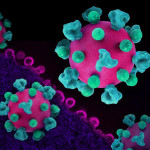People whose HIV levels drop more slowly after starting antiretroviral (ARV) therapy do just as well over two years as people whose virus drops rapidly, according to a research letter published in the June 19 issue of AIDS. These data potentially refute a long-standing theory that viral loads should decrease quickly during the initial months of treatment to maximize the chances of long-term success on a particular drug regimen.
In recent years, several studies have shown that some ARVs—especially Isentress (raltegravir)—are able to reduce HIV levels more rapidly than other drugs. Generally, experts define a rapid response as achieving a viral load of less than 50 copies within the first 12 weeks after starting treatment, and a slow response as achieving an undetectable viral load 12 to 24 weeks after starting treatment.
Theoretically, some researchers believe, a rapid response to treatment confers more benefits than a slower response, such as a greater likelihood of keeping viral load undetectable for a prolonged period of time. However, this hasn’t been proved.
To explore this hypothesis, Graham Moyle, MD, from Chelsea and Westminster Hospital in London, and his colleagues analyzed data from two studies—ARTEMIS and TITAN. Both studies involved people who were new to HIV treatment, and both compared Norvir (ritonavir)–boosted Prezista (darunavir) with Kaletra (lopinavir plus ritonavir).
Moyle and his colleagues found that people who had a slower virological response to treatment were no less likely to have an undetectable viral load 96 weeks after starting treatment than those who had a rapid response.
Moyle’s team did, however, find that a person’s pre-treatment viral load was associated with long-term treatment efficacy. Those with very high pre-treatment viral loads—though not defined by the authors, high baseline viral loads are generally those over 100,000—were more likely than those with lower virus levels to have their virus rebound with 96 weeks of starting treatment.
In the ARTEMIS study, people taking Kaletra were also more likely to have virus levels reemerge by 96 weeks than people taking Prezista.
The authors found that the results from TITAN and ARTEMIS are consistent with several other studies. In AIDS Clinical Trials Group (ACTG) 5142, people taking a Sustiva (efavirenz)-based regimen saw their viral loads drop more quickly than those taking a Kaletra-based regimen. After 96 weeks, however, people taking Kaletra were less likely to have developed drug resistance if they had treatment failure than those taking Sustiva.
Likewise, a study comparing Isentress with Sustiva found that similar proportions of those on both drugs maintained virus levels under 50 copies during the course of the study, despite the fact that people taking Isentress saw their viral loads plummet faster in the first weeks after initiating treatment.
The same dynamic appears to be true for people who are treatment experienced. The DUET study compared Intelence (etravirine)—plus an optimized background regimen of other drugs—with a placebo plus an optimized background regimen. In this study, as with the others, a quicker drop in virus levels did not predict long-term treatment success.
This recent emphasis on achieving a rapid response to treatment has likely caused at least some people to feel anxious if they took longer to reach undetectable after starting a new regimen. According to the authors, that anxiety might be groundless. They conclude: “These results from the ARTEMIS and TITAN trials show that the speed of initial suppression of HIV RNA in the first 24 weeks of antiretroviral treatment does not reliably predict whether patients will show long-term suppression at week 96.”
Advertisement
Advertisement
Advertisement






2 Comments
2 Comments